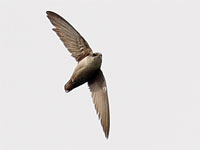
Spring is the prime season for migratory birds and just before nightfall small acrobatic birds may be plummeting into a brick chimney near you. If you witness such a sight the Fish & Wildlife Compensation Program (FWCP) wants to hear about it. FWCP’s Vaux’s (pronounced “voxes”) watch program is gearing up for the arrival of swifts in May.
In spring the Vaux’s swift makes its northward migration using communal roosting sites en route. However biologists have little knowledge of these sites and without that knowledge there is little chance to protect critical habitat. What is known is that brick chimneys — residential and commercial — are favoured resting stops as the swifts refuel and head from the southern United States and Mexico.
“We have very few reports of chimneys being used by Vaux’s swifts in the Basin even though swifts are seen in this region,” says FWCP senior wildlife biologist John Krebs. “In fact we are aware of only two active roosting sites; at St Eugene Mission near Cranbrook, and at Nelson’s Evangelical Covenant Church. There must be other locations out there and it is really important that we find them.”
The Vaux’s swift is North America’s smallest swift and is relatively easy to identify. At dusk they gather in the darkening skies, wheeling around for 20 or 30 minutes before swooping dramatically into a brick chimney or hollow tree trunk.
“They are quite a sight because communal roosting sites can accommodate from several tens of birds, to many thousands,” says FWCP public representative Gerry Thompson. In 2008 Thompson made nearly 30 massive Vaux’s swift nest boxes that have been distributed in various parts of the Basin.
The southern portion of the Columbia Basin provides important habitat for Vaux’s swifts as many breed in the forests of the Interior Cedar Hemlock zone. More than half of their global breeding sites occur in B.C. In addition to roosting in larger chimneys, Vaux’s swifts also nest in smaller chimneys from June to August. Very few nest sites have been documented for this species but they are likely to occur in brick chimneys. Towns with older houses and historic buildings are most likely to support nesting birds.
Historically the breeding and roosting sites consisted of hollow trees often found in old growth forests. With the creation of regional reservoirs and changes in forestry practices, however, such habitat has become more limited. In fact most recorded breeding and roosting sites are now in man-made brick chimneys; as more brick chimneys are converted to steel or aluminum, even this manmade habitat is in decline.
The FWCP, which works on behalf of its program partners BC Hydro, the B.C. Ministry of Environment, and Fisheries and Oceans Canada to conserve and enhance fish and wildlife impacted by the construction of BC Hydro dams, is requesting reports of Vaux’s swift roosting and nesting sites.
To report a roost site, or to learn more information about the FWCP Vaux’s Swift Watch Program, visit www.fwcp.ca, call (250) 352 6874 or email irene.manley@bchydro.com



